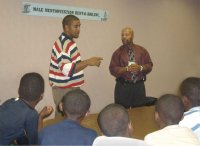It is possible to define adulthood using factors such as chronological age, financial and/or domestic independence as well as the nebulous concept of maturity. There was a discussion at the beginning of the course about how to define “young adults.” Is the label best applied to the traditional age range of 13 to 19? Or is it necessary to expand the parameters in order to reflect a social shift?
Statistics Canada reports that there has been a significant increase in the “the proportion of young adults aged 20 to 29 who resided in their parental home” (Human Resources, 2008). It is interesting that they exclude teenagers altogether from this category. The decision to return home can be the result of graduating from university, changing or losing a job, planning marriage or a divorce. All of these life circumstances often include some form of debt. They have been referred to as the “boomerang generation” or going through “adultescence” (Powers, 2007).
Consequently, young adult librarians may find themselves answering as many questions about resources for proper resume formatting and child custody as they do for high school projects on the solar system and the life cycle of trees.
In most cases, the aforementioned scenarios are temporary and individuals will resume their independence once their situation has stabilized. Unfortunately, there is a more worrisome trend that has been a focus of research by sociologists in recent years.
“Boys are in serious trouble. Doing worse in the classroom now than they did ten years ago. Hard to talk to. Unaware of their emotions. And the most violent in the industrialized world” (Thompson, 2008)
This can lead to a life characterized by endless drifting and insecurity. Many young males are abandoning or delaying responsibility as much as possible. They do this in favour of a life of recreation. This has most recently been addressed in State University of New York professor Michael Kimmel’s “Guyland: The Perilous World Where Boys Become Men.”
In it he describes “the wasteland between ages 16 and 26″ (Tucker, 2008) (an echo of the Statistics Canada figure that seems to be the common redefinition of young adulthood) when:
The guy is in no hurry to shed youthful egotism and hedonism and take up the mantle of adulthood. The Guy mentality is rooted in resentment, drenched in booze and dedicated to pervasive, sometimes violent denigration of women and gays. It’s a perpetual carnival of pornography, violent video games, hypermacho music and blustering talk-radio hosts who stoke resentment by constantly reminding Guys of the lost paradise that should have been theirs (ibid).
 One of the problems is a lack of suitable role models for boys as they grow up. This problem is recognized in the school system. In a report by Ontario educators, the province was urged to “act immediately to boost the already low and rapidly shrinking number of male teachers” (CBC, 2004).
One of the problems is a lack of suitable role models for boys as they grow up. This problem is recognized in the school system. In a report by Ontario educators, the province was urged to “act immediately to boost the already low and rapidly shrinking number of male teachers” (CBC, 2004).
However, I believe it is equally important to have male representation in public libraries, particularly in youth services departments. These males can be available throughout a youth’s academic career, whereas  exposure to a teacher typically lasts only one year. Furthermore, boys are required to go to school. Yet it is often observed that boys are not physically present in the library. There is some exciting and innovative library programming to address this issue. The ALA awarded its 2007 Diversity Award to Break-4-Boys: Male-2-Male Mentoring in which men speak and do activities with tweens and teens (ages 11–18) on a consistent basis. Mentorship is performed free for males by males (Nichols & Wilcox, 2007).
exposure to a teacher typically lasts only one year. Furthermore, boys are required to go to school. Yet it is often observed that boys are not physically present in the library. There is some exciting and innovative library programming to address this issue. The ALA awarded its 2007 Diversity Award to Break-4-Boys: Male-2-Male Mentoring in which men speak and do activities with tweens and teens (ages 11–18) on a consistent basis. Mentorship is performed free for males by males (Nichols & Wilcox, 2007).
This is is no way intended to deride the contribution of women to librarianship. However, at a time of decreasing literacy, particularly for recreation, the value of male staff in the library as role models for boys cannot be overstated.
References:
Canadian Broadcasting Corporation. 2004, November 13). Ontario urged to counter drop in male teachers.
Retrieved October 23, 2008, from: http://www.cbc.ca/canada/story/2004/11/12/male_teacher_041112.html
Human Resources and Social Development Canada. (2008). Family Life — Young Adults Living with their Parent(s) . Retrieved October 23, 2008, from: http://www4.hrsdc.gc.ca/indicator.jsp?lang=eng&indicatorid=77#MOREON_1
Nichols, K.D. and Wilcox, L.J. (2007). Male-2-Male Mentoring Is Working in Chicago Libraries. Information Today, Inc. Retrieved October 23, 2008, from: http://www.infotoday.com/mls/nov07/Nichols_Wilcox.shtml
Powers, G. (2007). What to do with boomerang kids. Sympatico MSN Finance. Retrieved Retrieved October 23, 2008, http://finance.sympatico.msn.ca/retirement/gordonpowers/article.aspx?cp-documentid=5767869
Thomspons, M. (2006). Raising Cain: Protecting the emotional life of boys. Retrieved October 23, 2008 from:
http://www.michaelthompson-phd.com/media.htm#cain
Tucker, C. (2008, October 5). ‘Guyland’ by Michael Kimmel: No girls or gays allowed. The Dallas Morning News. Retrieved October, 23, 2008, from: http://www.dallasnews.com/sharedcontent/dws/ent/stories/DN-bk_guyland_1005gd.ART.State.Edition1.269f7db.html
Posted in Community Outreach, Library Programs, Public libraries, Reading and Literacy, Representations of Youth, Research, Underserved and At-Risk Youth, YA librarianship





I could not agree with you more. In our 501 class way back when, we were asked if we thought the librarian stereotype (which is, any way you view it, decidedly female) was a detriment to our profession. And that question has haunted me ever since.
In my mind, the fact that our class was about 20% male spoke for itself. That stereotype — that “real men” aren’t librarians — is horrendously damaging not only to our profession because it belittles the work all librarians do. I read a paper that reported that less than 5% of children’s librarians are male. Correspondingly, boys often replied when asked that they didn’t think they -could- be librarians. I have a friend in his twenties who would love this program but who refuses to try it because he is extremely uncomfortable — “Wouldn’t I be, like, the only guy?”
The idea that men feel they “can’t” become librarians makes me as uncomfortable as women who feel they “can’t” become electrical engineers. It feels really wrong.
And in a rather silly way I almost feel uncomfortable as a woman going into children’s services, because I’m perpetuating a stereotype that excludes 50% of our population. I know it’s silly, but I still think about it.
Hi Kiirstin,
I greatly appreciate your very thoughtful reply and the insights you offer to supplement my post.
It is unfortunate that your friend feels troubled by the prospect of being the only guy. This has never bothered me. In elementary school I was the only male in the choir for two consecutive years.
Apparently the percentage of males in Youth Services is not improving. In the summer our Services for Children and Young Adults class took a tour of the Central Library. I specifically asked about males in the department and recall being told that of all the staff at LPL, only one male works with youth.
Take care,
Michael